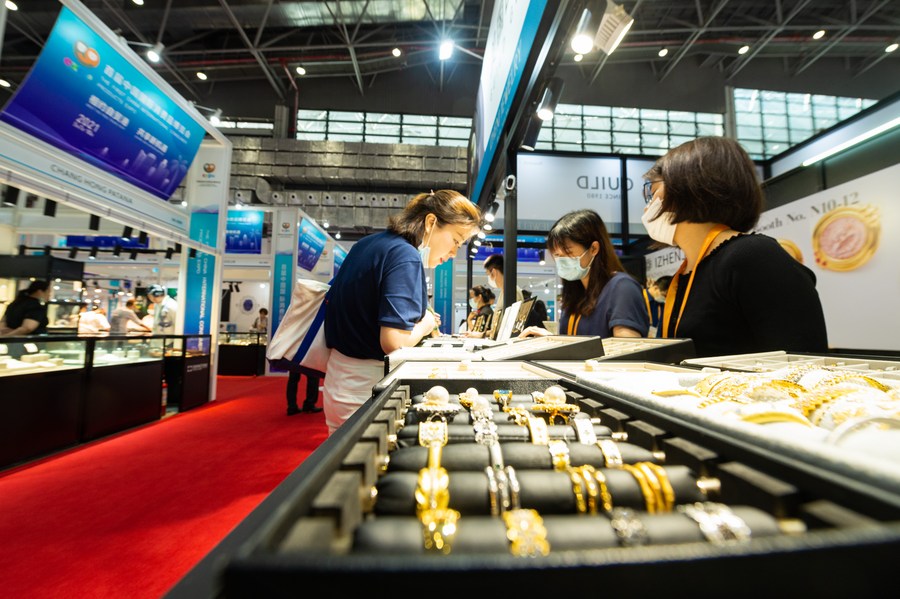China’s younger generation becomes new driving force for gold consumption
The younger generation in China is emerging as a new driving force that is propelling the country’s gold consumption, with a surge in their appetite for the precious metal.

A woman looks at products in the Jewelry Exhibition Hall of the first China International Consumer Products Expo in Haikou, capital of south China's Hainan Province, May 7, 2021. (Xinhua/Zhou Jiayi)
According to an industry report, one-third of surveyed gold and jewelry retailers said that in 2021 the consumption of gold jewelry by young consumers, namely those 25-years-old and younger, overtook the levels in 2019 at their stores.
China’s younger generation is expected to become the main consumer group for gold jewelry in the future, revealed the China Gold Association.
A survey indicated that 13 percent of young female consumers buy precious jewelry on an impulse or as a way to reward themselves, while 14 percent and 45 percent of those in this group have jumped on the bandwagon to make themselves happier and mark important anniversaries, respectively.
This growing demand for gold jewelry can be partly attributed to gold brands’ efforts to attract young consumers. Chinese gold brands like the Beijing-based Caishikou Department Store (Caibai Jewelry), the largest gold jewelry retailer in the capital, China Gold, and Hong Kong-listed Chow Tai Fook, have gone to extraordinary lengths to enhance their appeal to a younger generation of consumers, including satisfying their personalized needs. For example, they have rolled out a new gold jewelry series in collaboration with film and TV stars, Disney, the Palace Museum and other brands.
With an emphasis on the workmanship and design of their products, these gold brands have introduced novel products that are now gaining increasing popularity among young people, such as enamel gold jewelry and “Gufajin,” a kind of gold jewelry with a matte finish and exquisite designs.
Recently, counters selling enamel gold jewelry and Gufajin in the Caishikou Department Store have been packed with young consumers. “About 70 percent of our counters are displayed with enamel gold jewelry,” said a salesperson at a store in the Caishikou Department Store.
Since last year, many young consumers have also become more interested in 1-gram gold jewelry, which is usually priced at 300 yuan (about $47.2) or 400 yuan. “I can’t afford to buy 20-gram gold jewelry at a time, but a 1-gram one is not a problem,” said a fresh graduate.
A white-collar employee surnamed Xu said she set up a chat group where members can share the latest promotions on gold jewelry brands as advertised via e-commerce platforms, live-streaming sessions and brick-and-mortar stores in order to buy gold jewelry at relatively lower prices while taking advantage of discount coupons.
“The price of a gram of gold jewelry for traditional gold brands in some e-commerce livestreamers’ sessions is usually lower than that of the brands’ brick-and-mortar stores,” Xu added.
Meanwhile, gold’s appeal as a safe store of value is the most direct reason motivating young consumers’ increasing enthusiasm for gold jewelry.
“You can buy a gold pendant or an artificial crystal necklace at 2,000 yuan. Several years later, you can sell your gold pendant or take it as part of the payment for a new one. But nobody wants a second-hand artificial crystal necklace,” Xu said.
Photos
Related Stories
- Gold ornaments unearthed in ancient tombs in China's Shaanxi
- China's gold consumption surges 48.44 percent year-on-year as young consumers become driving force
- Sales of gold jewelry boom during Spring Festival holiday
- China gold output, consumption drop in first nine months
- China's Gao Lei wins gold of Trampoline Gymnastics at FIG World Cup
Copyright © 2022 People's Daily Online. All Rights Reserved.










